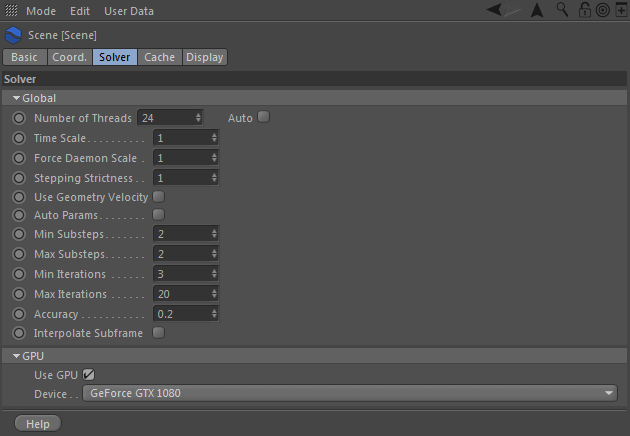/
Simulation Settings
Simulation Settings
RealFlow | Cinema 4D's simulation settings are located under the "Scene" object's "Solver" tab. During your daily work you will mostly deal with "Substeps" and "Iterations":
- Substeps determine the quality of the simulation.
- More substeps mean better, more accurate results, but also longer simulation times.
- The default settings ("Auto Params") work very good in scenes without interacting objects, e.g. pure liquid or granular simulations.
- In conjunction with collision objects, the default values are normally not sufficient.
- Increase the substeps in moderate steps, e.g. by 2 or 4 until you get the desired result (valid for → Liquid - PBD, → Granular, → Viscous, → Viscoelastic, → Rigid, → Elastic)
- The → Liquid - SPH fluid type works with rather high substeps already (Min = 1, Max = 300) and here it is normally not necessary to increase the values unless you work with high "Viscosity" settings.
Iterations are mainly relevant with "Granular", "Viscous", and "Viscoelastic" fluids, as well as the "Elastic" deformer:
- More iterations add viscosity and stiffness to the materials mentioned above, so be careful with high values (approx. greater than 50 or 75).
- Iterations are applied per substep: if you increase the number of substeps you will always get more viscosity/stiffness. Decrease iterations if necessary.
- If you encounter "popping" particles with "Liquid-PBD" and fluid-object interaction then it often helps to increase "Min Iterations", e.g. to 10 or 15.
A few more notes:
- "Number of Threads" specifies the number of processors/cores for the simulation. With "Auto" RealFlow | Cinema 4D will always use the maximum.
- You will hardly see any boost in simulation time with more than 32 threads.
- "Use Geometry Velocity" is only relevant if your project contains animated objects.
- "Use GPU" activates the simulation via your graphic card. We recommend reading the → linked page for more information about what's important.
Related content
From Zero to Render
From Zero to Render
Read with this
Simulation Settings
Simulation Settings
More like this
Meshing
Meshing
Read with this
Simulation Settings
Simulation Settings
More like this
Particle Rendering
Particle Rendering
Read with this
Simulation Settings
Simulation Settings
More like this
